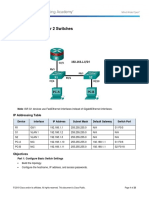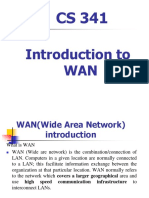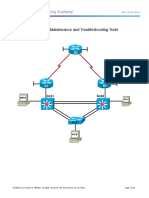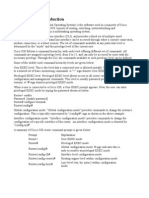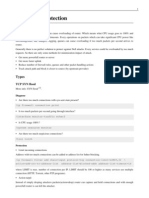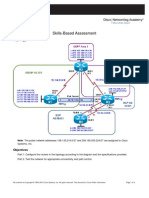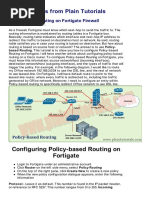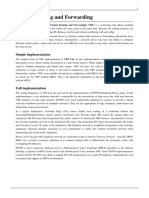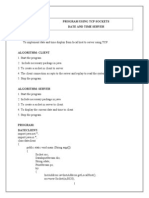0 ratings0% found this document useful (0 votes)
Ccna4-Lab 1: Nat & Pat: Scenario For NAT Configuration
Ccna4-Lab 1: Nat & Pat: Scenario For NAT Configuration
Uploaded by
Nhựt LưuThe document describes scenarios for configuring NAT, static NAT, dynamic NAT, and PAT on routers. It outlines the steps to configure static and dynamic NAT mappings between private and public IP addresses allocated by an ISP. It also describes configuring PAT to allow multiple private IP addresses to share a single public IP address for Internet access. Key steps include defining NAT pools, access lists, and interface configuration for inside and outside networks. The goal is to allow private addresses on company ABC's network to access the public Internet through the routers' public IP addresses allocated by their ISP.
Copyright:
© All Rights Reserved
Available Formats
Download as DOC, PDF, TXT or read online from Scribd
Download as doc, pdf, or txt
Ccna4-Lab 1: Nat & Pat: Scenario For NAT Configuration
Ccna4-Lab 1: Nat & Pat: Scenario For NAT Configuration
Uploaded by
Nhựt Lưu0 ratings0% found this document useful (0 votes)
The document describes scenarios for configuring NAT, static NAT, dynamic NAT, and PAT on routers. It outlines the steps to configure static and dynamic NAT mappings between private and public IP addresses allocated by an ISP. It also describes configuring PAT to allow multiple private IP addresses to share a single public IP address for Internet access. Key steps include defining NAT pools, access lists, and interface configuration for inside and outside networks. The goal is to allow private addresses on company ABC's network to access the public Internet through the routers' public IP addresses allocated by their ISP.
Original Title
Bai 5-2-NAT_PAT
Copyright
© © All Rights Reserved
Available Formats
DOC, PDF, TXT or read online from Scribd
Share this document
Did you find this document useful?
Is this content inappropriate?
The document describes scenarios for configuring NAT, static NAT, dynamic NAT, and PAT on routers. It outlines the steps to configure static and dynamic NAT mappings between private and public IP addresses allocated by an ISP. It also describes configuring PAT to allow multiple private IP addresses to share a single public IP address for Internet access. Key steps include defining NAT pools, access lists, and interface configuration for inside and outside networks. The goal is to allow private addresses on company ABC's network to access the public Internet through the routers' public IP addresses allocated by their ISP.
Copyright:
© All Rights Reserved
Available Formats
Download as DOC, PDF, TXT or read online from Scribd
Download as doc, pdf, or txt
0 ratings0% found this document useful (0 votes)
Ccna4-Lab 1: Nat & Pat: Scenario For NAT Configuration
Ccna4-Lab 1: Nat & Pat: Scenario For NAT Configuration
Uploaded by
Nhựt LưuThe document describes scenarios for configuring NAT, static NAT, dynamic NAT, and PAT on routers. It outlines the steps to configure static and dynamic NAT mappings between private and public IP addresses allocated by an ISP. It also describes configuring PAT to allow multiple private IP addresses to share a single public IP address for Internet access. Key steps include defining NAT pools, access lists, and interface configuration for inside and outside networks. The goal is to allow private addresses on company ABC's network to access the public Internet through the routers' public IP addresses allocated by their ISP.
Copyright:
© All Rights Reserved
Available Formats
Download as DOC, PDF, TXT or read online from Scribd
Download as doc, pdf, or txt
You are on page 1/ 2
Cantho University Network Training Center
CCNA4-Lab 1: NAT & PAT
Scenario for NAT configuration:
Company ABC has 30 public IP addresses 199.99.9.32/27 (199.99.9.33 – 199.99.9.39) from ISP.
The IT manager has decided to implement NAT: 199.99.9.33 – 199.99.9.39 for static allocation
and 199.99.9.40 – 199.99.9.62 for dynamic allocation.
Part 1: Configuration Static NAT
- Basic configuration (hostname, enable and telnet password, …) for each Router.
- Configure ip address, subnetmask, … for each interface on both Routers.
- Configure ip address, subnetmask, default gateway for each PC.
- On ISP router, create a static route to the Gateway router. Addresses 199.99.9.32/27
have been allocated for Internet access outside of the company.
ISP(config)#ip route 199.99.9.32 255.255.255.224 200.2.2.18
“No route to 10.10.10.0 /24 network (private - LAN), only has route to real addresses.”
- On Gateway router, create the default route to Internet.
Gateway(config)# ip route 0.0.0.0 0.0.0.0 200.2.2.17
- Configuring static mapping: assign 1 public IP address for PC1.
Gateway(config)# ip nat inside source static 10.10.10.10 199.99.9.33
- Specify the interfaces to setup NAT.
Gateway(config)# interface Fa0
Gateway(config-if)#ip nat inside
Gateway(config-if)#interface S1
Gateway(config-if)#ip nat outside
- Testing the configuration.
Check NAT translation, by using command:
Gateway(config)# show ip nat translations
Ping from PC1 to Loopback 0 of ISP.
From ISP Router, ping 10.10.10.10
From ISP Router, ping 199.99.9.33
- Verifying NAT configuration: Gateway(config)# show ip nat statistic
Part 2: Configuration Dynamic NAT
- Configure 5 first steps as in Part 1.
- Define the pool of public addresses.
Gateway(config)# ip nat pool ABCPool1 199.99.9.40 199.99.9.62
netmask 255.255.255.224
- Define an access list that will match the inside private IP addresses.
Gateway(config)# access-list 1 permit 10.10.10.0 0.0.0.255
- Define the NAT translation from inside list to outside pool.
Gateway(config)# ip nat inside source list 1 pool ABCPool1
- Specify the interfaces to setup NAT.
Gateway(config)# interface Fa0
Gateway(config-if)#ip nat inside
Gateway(config-if)#interface S1
Gateway(config-if)#ip nat outside
- Testing the configuration.
Not To Be Distributed Page 1 of 2
Cantho University Network Training Center
Check NAT translation, by using command:
Gateway(config)# show ip nat translations
Ping from PC2 to Loopback 0 of ISP. Check address translation.
- Verifying NAT configuration: Gateway(config)# show ip nat statistic
Scenario for PAT configuration:
Company ABC has 1 Internet connection. The ISP has allocated only 1 IP address to be used on the
serial port of his remote access device. All PCs on ABC network will share 1 public IP address on
the router using PAT.
Part 3: Configuration PAT
- Basic configuration (hostname, enable and telnet password, …) for each Router.
- Configure ip address, subnetmask, … for each interface on both Routers.
- Configure ip address, subnetmask, default gateway for each PC.
- On Gateway router, create the default route to Internet.
Gateway(config)# ip route 0.0.0.0 0.0.0.0 S1
- Define an access list that will match the inside private IP addresses.
Gateway(config)# access-list 1 permit 10.10.10.0 0.0.0.255
- Define the PAT translation from inside list to outside address.
Gateway(config)# ip nat inside source list 1 interface S1 overload
or
define the pool of public address and configure PAT translation designated in the pool
Gateway(config)# ip nat pool ABCPool1 199.99.9.40 199.99.9.62
netmask 255.255.255.224
Gateway(config)# ip nat inside source list 1 pool ABCPool1 overload
- Specify the interfaces to setup PAT.
Gateway(config)# interface Fa0
Gateway(config-if)#ip nat inside
Gateway(config-if)#interface S1
Gateway(config-if)#ip nat outside
- Testing the configuration.
Check PAT translation, by using command:
Gateway(config)# show ip nat translations
Ping from PC1 to Loopback 0 of ISP. Check address translation.
Open many DOS Prompt, ping to Lo0 port of ISP. Check address translation.
Telnet from PC1 to Loopback 0 of ISP. Check address translation.
- Verifying NAT configuration: Gateway(config)# show ip nat statistic
Not To Be Distributed Page 2 of 2
You might also like
- Configuring IPCop Firewalls: Closing Borders with Open SourceFrom EverandConfiguring IPCop Firewalls: Closing Borders with Open SourceNo ratings yet
- Why MPLS?: Hat Is MPLS (Multi-Protocol Label Switching) ?No ratings yetWhy MPLS?: Hat Is MPLS (Multi-Protocol Label Switching) ?7 pages
- CCNA 1 Routing and Switching - Introduction To Networks Final Exam - CisacadNo ratings yetCCNA 1 Routing and Switching - Introduction To Networks Final Exam - Cisacad27 pages
- 7.2.4.3 Laboratorio Cisco Paket Tracer para Certificacionb0% (1)7.2.4.3 Laboratorio Cisco Paket Tracer para Certificacionb22 pages
- OSPF "Magic" Exercise: We Will Use A "Quick and Dirty" Setup To Make OSPF Work With Minimal ConfigurationNo ratings yetOSPF "Magic" Exercise: We Will Use A "Quick and Dirty" Setup To Make OSPF Work With Minimal Configuration4 pages
- Ethernet: Outline Multiple Access and Ethernet Intro Ethernet Framing CSMA/CD Protocol Exponential BackoffNo ratings yetEthernet: Outline Multiple Access and Ethernet Intro Ethernet Framing CSMA/CD Protocol Exponential Backoff25 pages
- Private VLAN Example (Step 1) : Internet Access100% (1)Private VLAN Example (Step 1) : Internet Access4 pages
- Chapter 4. Using The Command-Line InterfaceNo ratings yetChapter 4. Using The Command-Line Interface22 pages
- Chapter 7 Lab 7-1, Synchronizing Campus Network Devices Using Network Time Protocol (NTP)No ratings yetChapter 7 Lab 7-1, Synchronizing Campus Network Devices Using Network Time Protocol (NTP)20 pages
- CCNPv7 TSHOOT Lab3 1 Assembling Maintenance and Troubleshooting Tools StudentNo ratings yetCCNPv7 TSHOOT Lab3 1 Assembling Maintenance and Troubleshooting Tools Student44 pages
- Prep For CCIE SP Lab Exam v3.0 Part - 6 of 7No ratings yetPrep For CCIE SP Lab Exam v3.0 Part - 6 of 736 pages
- Policy Based Routing On Fortigate FirewallNo ratings yetPolicy Based Routing On Fortigate Firewall2 pages
- Destination NAT Lab:: Basic Devices ConfigurationNo ratings yetDestination NAT Lab:: Basic Devices Configuration12 pages
- Basics of Networking: Created by Ashish LohiaNo ratings yetBasics of Networking: Created by Ashish Lohia47 pages
- Optical and Microwave Technologies for Telecommunication NetworksFrom EverandOptical and Microwave Technologies for Telecommunication NetworksNo ratings yet
- Lab 7.4.1: Basic DHCP and NAT Configuration: Topology DiagramNo ratings yetLab 7.4.1: Basic DHCP and NAT Configuration: Topology Diagram14 pages
- Lab 1: Basic Cisco Device Configuration: Topology DiagramNo ratings yetLab 1: Basic Cisco Device Configuration: Topology Diagram16 pages
- CCNA4-Lab 2: DHCP: Scenario For DHCP ConfigurationNo ratings yetCCNA4-Lab 2: DHCP: Scenario For DHCP Configuration2 pages
- Lab 5.5.1: Basic Access Control Lists: Topology DiagramNo ratings yetLab 5.5.1: Basic Access Control Lists: Topology Diagram12 pages
- Lab 11.5.4: Network Testing: Topology DiagramNo ratings yetLab 11.5.4: Network Testing: Topology Diagram7 pages
- M-ALU-0051560 - Bldg. of Omar Abdullah - ZNJ3880% (1)M-ALU-0051560 - Bldg. of Omar Abdullah - ZNJ38818 pages
- Success Story: Osk DHCP in Pure Python: Manyong LeeNo ratings yetSuccess Story: Osk DHCP in Pure Python: Manyong Lee12 pages
- Provides Update Free of Charge in One Year!: Dump StepNo ratings yetProvides Update Free of Charge in One Year!: Dump Step6 pages
- KVM Libvirt Assign Static Guest IP Addresses Using DHCP On The Virtual MachineNo ratings yetKVM Libvirt Assign Static Guest IP Addresses Using DHCP On The Virtual Machine3 pages
- Jamal Randolph: P.O. Box 674504, Marietta, GA 30006 Tel: 678-994-2464No ratings yetJamal Randolph: P.O. Box 674504, Marietta, GA 30006 Tel: 678-994-24643 pages
- Why Traditional Security Solutions Are Not Adapted To Protect DNS ServicesNo ratings yetWhy Traditional Security Solutions Are Not Adapted To Protect DNS Services5 pages
- Week 5: Tanzeel Ur Rehman (Lecturer, Elite Colleges)No ratings yetWeek 5: Tanzeel Ur Rehman (Lecturer, Elite Colleges)49 pages
- Ex No:1 (I) Program Using TCP Sockets Date and Time Server Date: AimNo ratings yetEx No:1 (I) Program Using TCP Sockets Date and Time Server Date: Aim58 pages
- Nexus Switching: Cisco's Network Operating SystemsNo ratings yetNexus Switching: Cisco's Network Operating Systems8 pages







